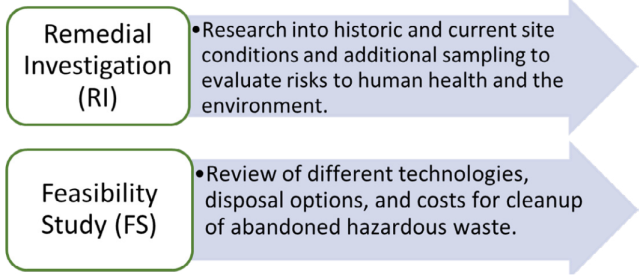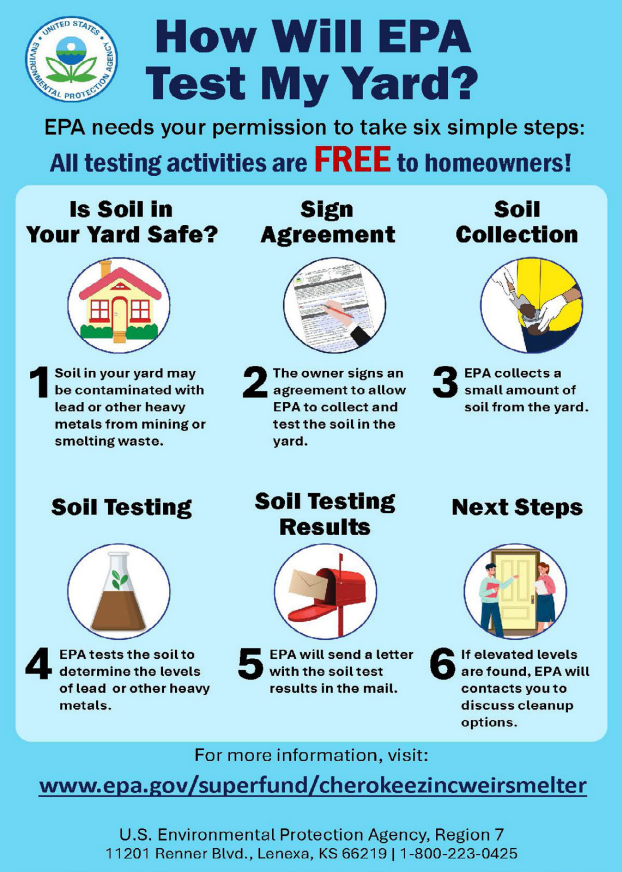Cherokee Zinc - Weir Smelter NPL Superfund Site Update Fact Sheet – Weir, Cherokee County, Kansas, September 2025
Cherokee Zinc - Weir Smelter NPL Superfund Site Update Fact Sheet

Site Overview
The Cherokee Zinc - Weir Smelter National Priorities List (NPL) Superfund Site is located in Weir, Cherokee County, Kansas. The site is a part of the Tri-State Mining District, where mining, milling, and smelting of lead and zinc ore occurred for more than 100 years. This site was added to the National Priorities List (NPL) in 2021. The NPL is a list of the nation’s hazardous waste sites with the highest priority for cleanup under the Comprehensive Environmental Response, Compensation, and Liability Act (CERCLA), commonly known as Superfund. EPA’s Remedial Investigation (RI) and Feasibility Study (FS) is currently underway to better understand the extent of the contamination at the site.
Site Background
The Chicago Zinc Works Company began smelting zinc in 1872. The company chose Weir as the location, due to nearby commercial coal deposits available to fuel the smelter and the proximity to the Tri-State Mining District. According to historical information, smelting operations closed around 1918 when natural gas wells in other areas of Kansas made smelter operations relying on coal less profitable. The smelting emitted air pollution (soot) containing lead, cadmium, and zinc that deposited on surface soils across the area. Arsenic may also be present from the use of coal power. These contaminants are invisible to the eye in soils. To protect the public from lead hazards and prevent childhood lead poisoning, EPA offers residential yard testing (sampling) and remediation (cleanup) of eligible residential properties.
Site Cleanup to Date
After the site was added to the NPL, EPA created two project areas known as Operable Units (OUs) to address contamination in residential soils and at the former smelter property.
- OU1 – Residential Yards
- OU2 – Former Smelter
To date, EPA’s removal program has cleaned up lead contamination at 54 residential properties. Additional residential properties are scheduled for cleanup throughout 2025.
Remedial Investigation/Feasibility Study
Both OU1 and OU2 are currently in the RI/FS stage of the Superfund process. This includes the characterization of site conditions and determining the nature and extent of the contaminated wastes across the site.

Once completed, EPA will present to the public a Proposed Plan to clean up the site and document the selected remedy in a Record of Decision. Throughout the Superfund process, EPA will continue to inform and involve the affected community.
Learn more about the Superfund process and the RI/ FS on EPA's Superfund Cleanup Process page.

Lead Testing & Cleanup of Residential Yards
How Do I Participate? If you would like to have your residential yard (soils) tested for potential lead contamination for free, please contact us today! EPA needs property owner permission to test your yard for potential lead contamination. The residential yard testing process includes a few simple steps to test and/or clean up your property.
Contact EPA or EPA’s sampling contractor, Tetra Tech, to give EPA permission to sample your yard for lead or other heavy metals associated with historic industry on the site.
- Call EPA’s contractor, Tetra Tech, at 417-385-8487.
Call EPA toll-free: 1-800-223-0425, or email EPA: r7-tsmd@epa.gov; see EPA contacts to sign up.
Technical Assistance & Grant
EPA wants to help affected communities understand the technical information related to a site. EPA’s Technical Assistance Grant program provides up to $50,000 for a qualified citizens group to hire independent technical advisors.
Advisors can help citizens interpret technical data, understand site hazards, and become more knowledgeable about the different technologies used to clean up sites. Learn more about technical assistance on EPA's Superfund Community Involvement page.
Annual Childhood Lead Testing
Lead is a toxic metal that is harmful if inhaled or swallowed and can pose serious health risks, particularly to children under 7 years old, as well as pregnant women and nursing mothers. The only way to know if your child has elevated levels of lead in their blood is to have a blood test. Talk to your physician, pediatrician, or the Cherokee County Health Department at 620-429-3087.
To learn how to prevent lead exposure, visit:
- EPA's Lead page
- CDC's About Childhood Lead Poisoning Prevention page
- Protect Your Family from Lead Hazards in Historic Lead Mining Areas – Fact Sheet, August 2022
Additional Information
Site project information and reference materials are available to the public at an online information repository. To view site information, technical cleanup documents, and Administrative Record, visit EPA's Cherokee Zinc - Weird Smelter page (see Site Documents & Data).
If you do not have internet access, you can also view these documents online during normal business hours a local library, such as the Weir Public Library, 111 E. Main St., Weir, KS; 620-396-8899. Fact Sheets for Kansas sites are also posted at EPA's Kansas - Cleanups page.
Site Contacts
EPA encourages community members to reach out to us. Questions, comments, or requests for site information can be directed to EPA (see contact email addresses and phone numbers below):
Rachael Puleo
Remedial Project Manager
U.S. EPA Region 7 (SEMD/LMSE/SES)
11201 Renner Boulevard
Lenexa, KS 66219
Email: puleo.rachael@epa.gov
Phone: 816-912-8844
Toll-free: 1-800-223-0425
Tanya Young
Community Involvement Coordinator
U.S. EPA Region 7 (CEERD/CPSIB)
11201 Renner Boulevard
Lenexa, KS 66219
Email: young.tanya@epa.gov or r7-tsmd@epa.gov
Phone: 816-799-3251
Toll-free: 1-800-223-0425
